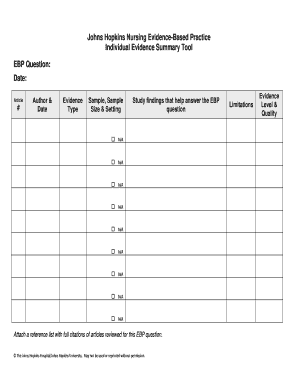
Get Johns Hopkins Individual Evidence Summary Tool 2020-2025
How it works
-
Open form follow the instructions
-
Easily sign the form with your finger
-
Send filled & signed form or save
How to fill out the Johns Hopkins Individual Evidence Summary Tool online
The Johns Hopkins Individual Evidence Summary Tool is essential for documenting the results of evidence appraisal for evidence-based practice projects. This guide provides clear, step-by-step instructions to help users complete the form accurately and effectively.
Follow the steps to complete the evidence summary tool online.
- Click ‘Get Form’ button to obtain the tool and open it in the editor.
- In the header section, enter the EBP question and the date of the EBP project for reference.
- In the Article # field, assign a number to each reviewed source of evidence. This will help organize your summary and make it easier to reference articles.
- In the Author and Date section, indicate the last name of the first author or evidence source, and provide the publication or communication date. This helps differentiate between sources from the same author.
- Indicate the Evidence Type by selecting the category of evidence reviewed, such as randomized controlled trial, meta-analysis, or qualitative study.
- For the Sample, Sample Size, and Setting field, provide details relevant to evidence levels I, II, III, and level V quality improvement evaluations, including the population, the number of participants, and the study location.
- In the Study Findings section, summarize findings that directly address your EBP question. Concentrate on the points that are most pertinent to your inquiry.
- In the Limitations section, include any identified drawbacks of the evidence, whether mentioned in the text or recognized during your review.
- Transfer the evidence level and quality rating into the Evidence Level and Quality column using the information from your appraisal tools.
- Once all fields are complete, save your changes, and consider downloading, printing, or sharing the completed form as needed.
Start completing your evidence summary tool online today to enhance your evidence-based practice project!
The PET process used by the JHNEBP model involves planning, engaging, and taking action based on evidence. This process is designed to help healthcare professionals systematically apply the best available evidence to their practice. By leveraging resources like the Johns Hopkins Individual Evidence Summary Tool, practitioners can navigate this process efficiently and effectively.
Industry-leading security and compliance
-
In businnes since 199725+ years providing professional legal documents.
-
Accredited businessGuarantees that a business meets BBB accreditation standards in the US and Canada.
-
Secured by BraintreeValidated Level 1 PCI DSS compliant payment gateway that accepts most major credit and debit card brands from across the globe.


